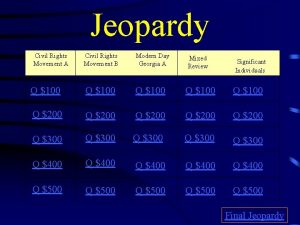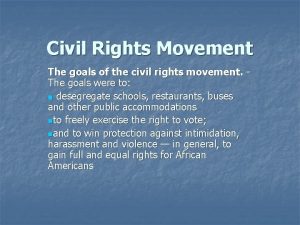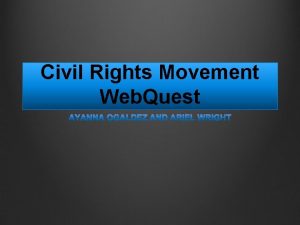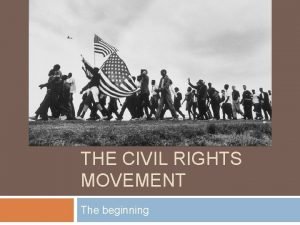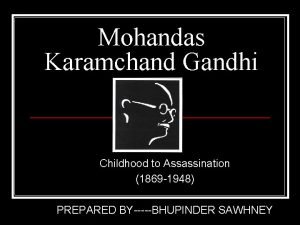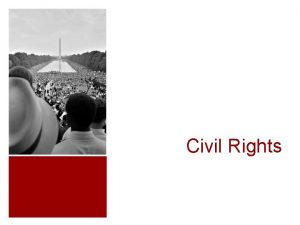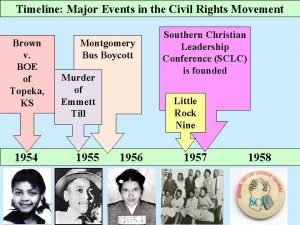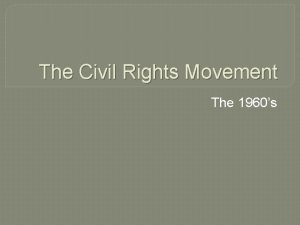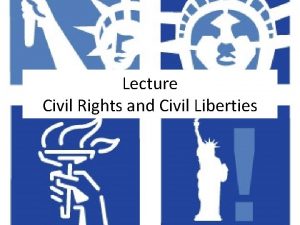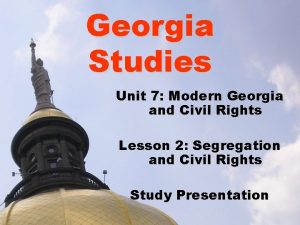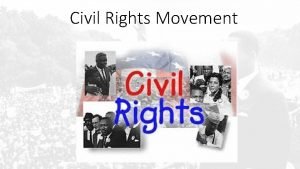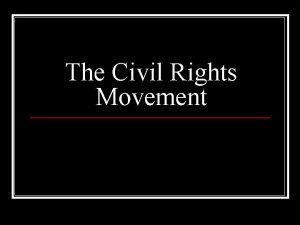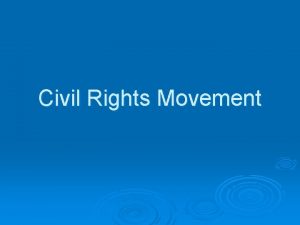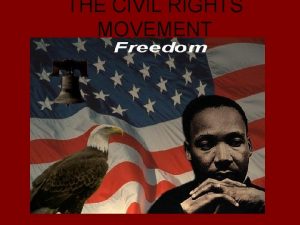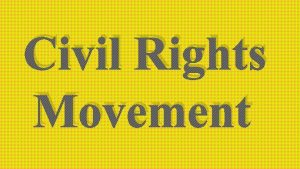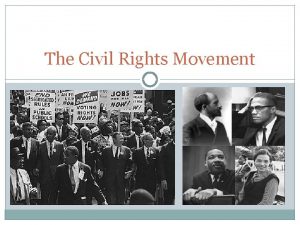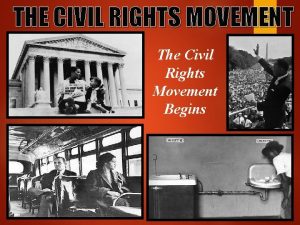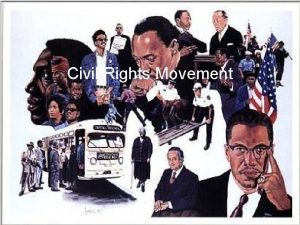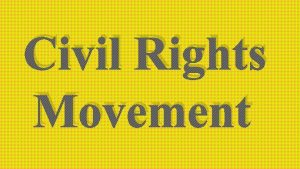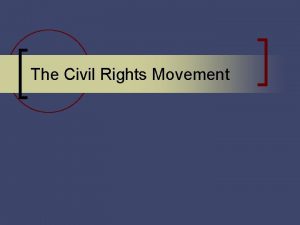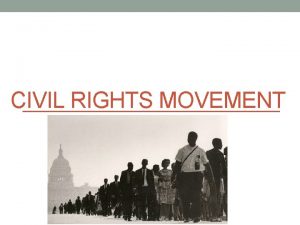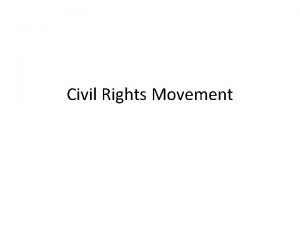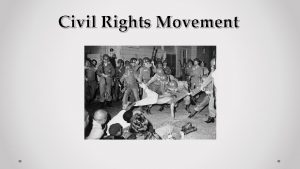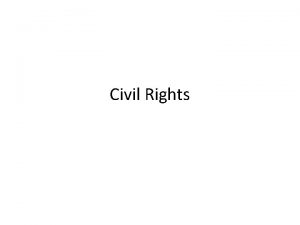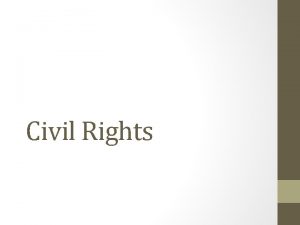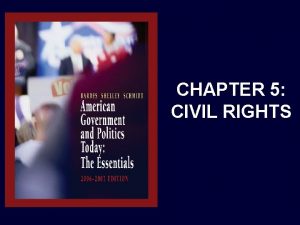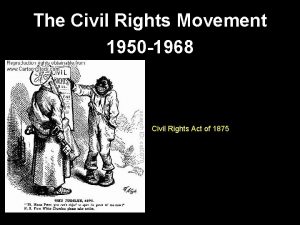Civil Rights Lecture Why Civil Rights movement Rise
























- Slides: 24

Civil Rights Lecture Why Civil Rights movement? *Rise of Urban Ghettos -isolated from economic mainstream- interest group politics -lacked political power- majoritarian politics *Emergence of Civil Rights was a painful process, but was speeded along because of: -the emergence of white allies -shifting to policy-making arenas where southern whites had less of an advantage -pressure from blacks themselves that rose civil rights to prominence -Liberal justice- Earl Warren

Civil Rights Issue: Group denied access to facilities, opportunities, or services available to other groups The issue is whether differences in treatment are reasonable. In some cases, they are- progressive taxes In some cases they are not- classifications by race or ethnicity are subject to strict scrutiny

Court Cases n Plessy v. Ferguson (1896) -Separate but equal Ambiguities of the 14 th Amendment - Broad Interpretation: the Constitution is colorblind, so no differential treatment is acceptable - Narrow interpretation: equal legal rights, but blacks and whites could otherwise be treated differently The Court chose the narrow interpretation

NAACP Strategy Three step process: 1. Persuade the Court to declare unconstitutional the laws creating schools that were separate but unequal 2. Persuade the Court to declare unconstitutional the laws creating schools that were separate but so obviously unequal 3. Persuade the Court to rule separate schools are inherently unequal and therefore unconstitutional

Step One: Obvious inequalities addressed between 1938 -1948 cases -Lloyd Gaines -Ada Lois Sipuel Step Two: Separation creates inequality in less obvious cases -Heman Sweatt -George Mc. Laurin

Step three: Declaring that separation is inherently unequal Brown v. Board of Education (1954) -class action suit -schools could not be separated by race -integration is necessary -Earl Warren “in the field of public education the doctrine of separate but equal has no place. ” -must correct with “all deliberate speed” -relied on social science rather than 14 th Amendment because the Court wanted a unanimous decision Resistance: Southern Manifesto

Montgomery Bus Boycott n n n Segregated public transport December 1955 - Rosa Parks refuses to give up her seat and move to the back of the bus MLK Jr. , Dexter Church, organized a bus boycott Southern Christian Leadership Conference (founded 1951) support strike 381 day boycott; carpools, bikes, walk Supreme Court rules segregation on buses illegal

Little Rock 9 Incident n n n 1957, Little Rock school board moved to integrate the high school Gov. Faubus sent in the National Guard to keep nine black children from attending the high school Eisenhower sends in 1000 Federal Troops (paratroopers)- stay with the students all year Faubus closed down the school in 1958 Faubus loses the court battle and the school is reopened in 1959 with three black students.

Greensboro n n n Feb. 1960 Greensboro, NC at a Woolworth’s lunch counter Four black college freshmen sit down and ask to be served First sit in Followed by bigger sit in crowd every day April 1960, SNCC formed (Student Non-violent Coordinating Committee) Peaceful sit ins, demonstrations, freedom marches, freedom rides.

Desegregation v. Integration -De jure segregation in the South -De facto segregation in the North How does the Court deal with this? Charlotte-Mecklenberg Case: sets guidelines for integration: -to violate the Constitution, a school system must have intended to discriminate -one-race schools create the presumption of intent -remedies for past discrimination can include quotas, busing, redrawn district lines -not every school must reflect the racial composition of the entire system White Flight creates single race schools

Opponents to Civil Rights legislation had strong defensive positions: -Senate judiciary committee controlled by Southern Democrats -House Rules Committee controlled by Howard Smith (VA) -Senate filibuster threat -Kennedy a northerner reluctant to submit strong civil rights legislation

Four developments begin to turn the tide: -Public opinion starts to change -Violent white reactions of segregationists received extensive media coverage -Kennedy assassination --1964 Democratic landslide allowed northern Democrats to prevail in Congress

Kennedy and Civil Rights n n 1962 JFK signs bill to desegregate housing (Bobby instrumental) June 1963 Kennedy gives civil rights speech same night Medgar Evers (head of NAACP) murdered. Much of the proposed legislation by Kennedy is blocked by the conservative congress.

March on Washington n n n August 1963 Martin Luther King Jr. leads a Civil Rights March on Washington Delivers the “I have a dream” speech “Free at last, free at last! Thank God Almighty, we are free at last!” Singing “We Shall Overcome” 200, 000 people – or more(blacks and whites) Sept. 1963 - bomb exploded in Birmingham church and kills four little girls

Kennedy Assassination n n n November 22, 1963 Dallas, TX While riding in an open limousine, Kennedy shot in the head Lee Harvey Oswald the lone gunman? Official investigation led by Earl Warren left many questions unanswered LBJ sworn in on Air Force One The nation mourns

LBJ and Civil Rights Act of 1964 -prohibited discrimination because of race, color, religion, or national origin -all citizens have the right to enter parks, restaurants, bathrooms, etc. . -forbade discrimination in schools -creates EEOC (Equal Employment Opportunity Comm. ) n Voting Rights Act (1965) -eliminated literacy tests, -allowed federal (not state) examiners to register voters -24 th Amendment- no poll taxes n

Women and Equal Rights Reasonableness standard v. strict scrutiny Court chooses a blend Prohibited differences: -Age of adulthood -Arbitrary height-weight requirements -Drinking age -Mandatory pregnancy leaves -Little league exclusion -Business and professional associations -Retirement benefits -Salaries for high school coaches of girls and boys Allowed differences: -statutory rape -all boy/all girl public schools -widow’s property tax exemption -delayed promotions in Navy -the draft

Sexual harassment: Two forms: Disallowed by Court Quid Pro Quo- sexual favors in return for holding the job or for promotion Hostile environment, creating a setting in which harassment impairs ability to work

Abortion: -decided by states until 1973 Roe v. Wade- 1973 - struck down all state bans on abortion -Women’s right to choose protected by the 14 th Amendment -First trimester- no restrictions -Second trimester- no ban but regulations to protect the health of the woman -Third trimester-abortion ban is possible

Critics: - life begins at conception -fetus is a person entitled to equal protection guaranteed by the 14 th Amendment -right to life, pro-life position Supporters: -No one can know when life begins -right to choose, pro choice position

Congressional Action: Constitutional Amendments to overturn Roe did not pass Congress Hyde Amendment (1976) no federal funds for abortion except when the woman’s life is endangered -Constitutionally upheld in 1980

Affirmative Action: Equality of results -racism and sexism can be overcome only by taking them into account when designing remedies -equal rights are not enough- people need benefits -affirmative action should be used in hiring -supporters tend to be liberals Equality of Opportunities -reverse discrimination occurs when race or sex is used as a basis for preferential treatment -laws should be color blind and sex-neutral -government should only eliminate barriers -supporters tend to be conservative

Emerging standards for quotas and preference systems: -Quota system subjected to strict scrutiny- must be a compelling state reason to justify quotas -must correct an actual pattern of discrimination -must identify actual practices that discriminate -Federal quotas will be given deference because the Constitution gives Congress greater power to correct the effects of racial discrimination Compensatory action versus preferential treatment: Public supports the former but not the latter

Gays and the Supreme Court: -Georgia case allows states to ban homosexual activity -Colorado case prohibits law that would deny homosexuals the “equal protection of the law”. -Don’t ask, Don’t tell repealed -Boston case allows people to exclude those with whom they disagree -Michigan law bans benefits to same sex partners
 Civil rights webquest
Civil rights webquest Rosa parks mother
Rosa parks mother Civil rights movement jeopardy
Civil rights movement jeopardy Civil rights movement goal
Civil rights movement goal Civil rights movement vocabulary
Civil rights movement vocabulary Civil rights movement webquest
Civil rights movement webquest The civil rights movement
The civil rights movement Civil rights movement essential questions
Civil rights movement essential questions Hey hey bye bye
Hey hey bye bye Sheep become lions
Sheep become lions Tricky dick: the rise and fall and rise of richard m. nixon
Tricky dick: the rise and fall and rise of richard m. nixon Little lambs academy
Little lambs academy A union b example
A union b example 01:640:244 lecture notes - lecture 15: plat, idah, farad
01:640:244 lecture notes - lecture 15: plat, idah, farad Dont ask
Dont ask Why did new conservatism rise
Why did new conservatism rise Program of civil disobedience movement
Program of civil disobedience movement Civil right movement def
Civil right movement def Movement area
Movement area Different axial movements
Different axial movements Civil rights timeline of events
Civil rights timeline of events Civil rights sitins
Civil rights sitins Impressionism apush
Impressionism apush Define civil rights
Define civil rights Unit 7 modern ga and civil rights
Unit 7 modern ga and civil rights


